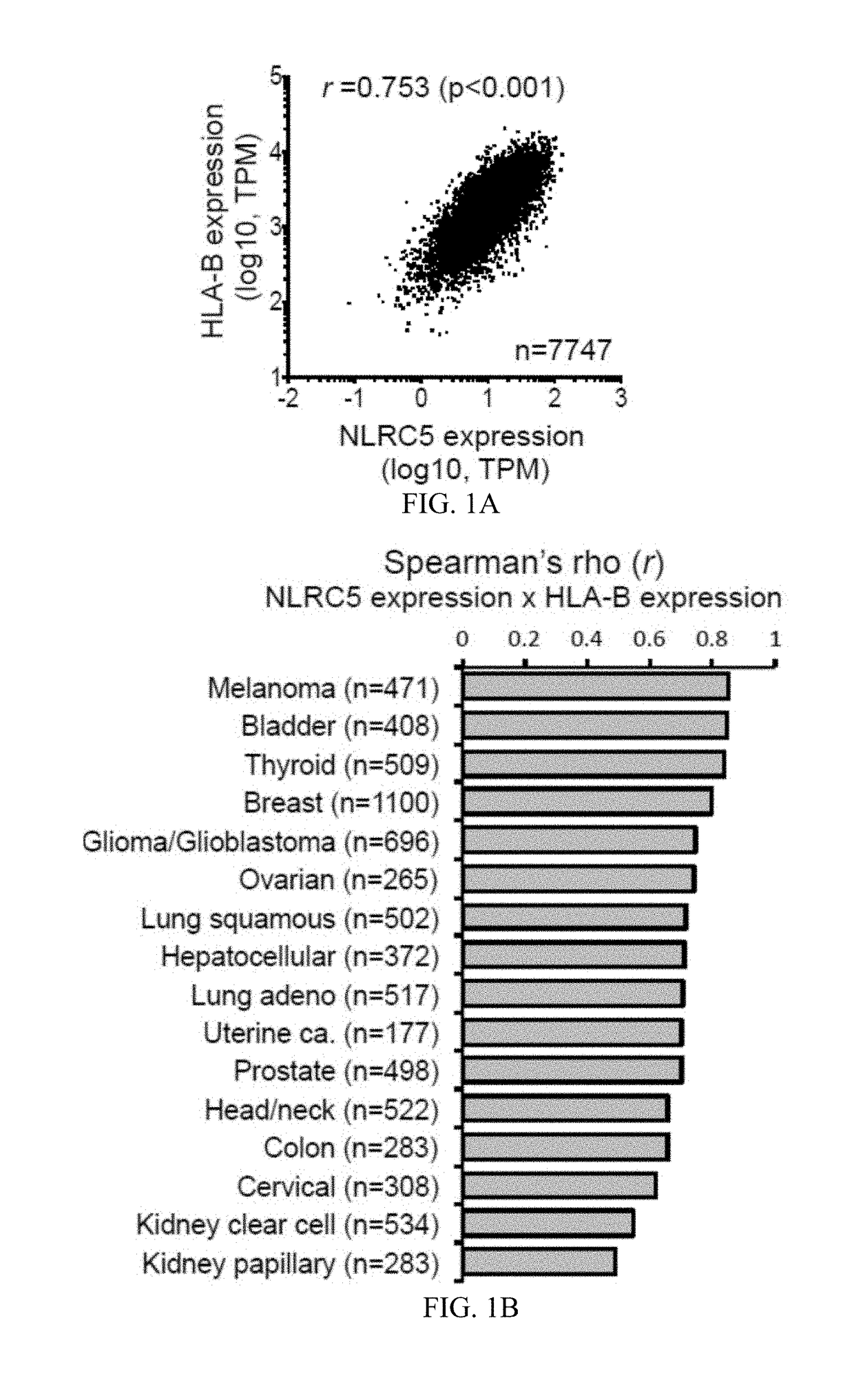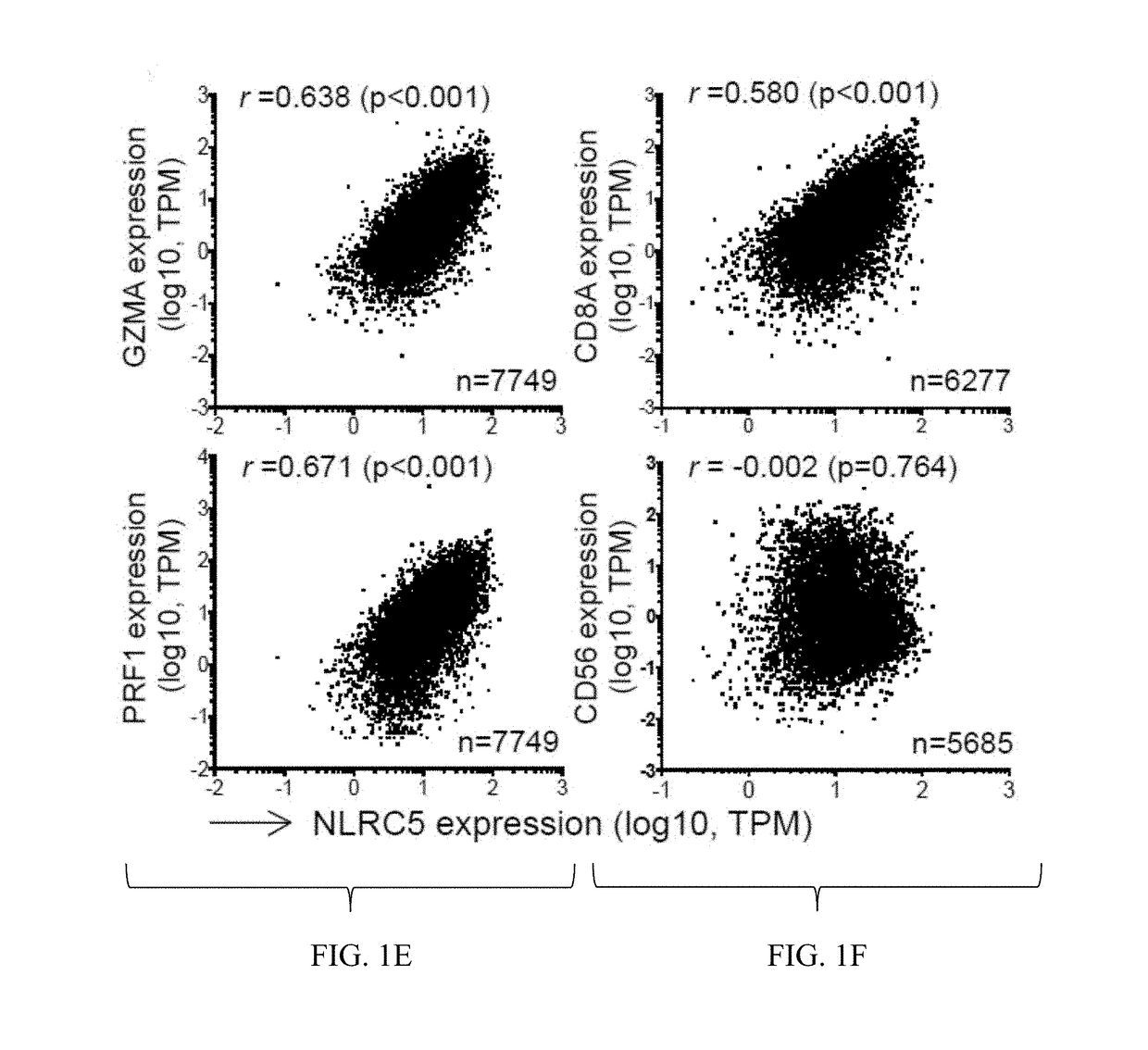Nlrc5 as a biomarker for cancer patients and a target for cancer therapy
a cancer patient and biomarker technology, applied in the field of nlrc5 as a biomarker for cancer patients and a target for cancer therapy, can solve the problems of negligible effectiveness and none of these mechanisms explain the cancer immune evasion phenotype in a broad range of malignancies, and achieve the effect of reducing the copy number of nlrc5
- Summary
- Abstract
- Description
- Claims
- Application Information
AI Technical Summary
Benefits of technology
Problems solved by technology
Method used
Image
Examples
example 2
on of Nlrc5, but not of Other MHC Class I Genes, is Selectively Used in Cancers to Evade Immunity
[0288]Epigenetic changes in cancer cells represent an important mechanism to alter gene expression in favor of cancer growth and immune evasion. Abnormal methylation of CpG islands in promoter regions can transcriptionally suppress genes which are unfavorable for cancer growth. Treatment of various cancer cell lines with a DNA-methylation inhibitor, 5-Azacitidine, resulted in the upregulation of nlrc5 and hla-b expression, suggesting that methylation of the nlrc5 promoter plays a role in the loss of MHC class I expression in cancer (FIG. 2A). Therefore, the level of DNA methylation at a CpG island in the nlrc5 promoter was quantified using a methylation-specific probe (FIG. 2B) and compared with the expression level of nlrc5. Analysis of biopsy samples from 6523 solid cancer patients revealed that methylation of the nlrc5 promoter negatively correlated with nlrc5 expression (rs=−0.585) (...
example 3
lls Selectively Lose the Nlrc5 Gene at a High Frequency and Induce Reduced Expression of MHC Class I Genes
[0289]Changes of somatic gene copy number are frequently observed in cancer cells and associated with alteration of gene expression levels. The analysis of copy number in the cohort of 7730 cancer patients showed that all cancer types carry alterations in copy number of the nlrc5. Copy number loss (copy number=0 or 1) was observed in 28.6% of cancer patients, with the highest frequency in ovarian cancer patients (72.2%) (FIG. 3A). Remarkably, copy number loss occurred in nlrc5 at the highest frequency among MHC class I and related genes in the entire cancer cohort and in ovarian cancer, followed by b2m (FIG. 3B), again indicating that nlrc5 is a preferential target for cancer immune evasion among genes involved in the MHC class I pathway. Gene expression analysis demonstrated that patients with copy number loss showed reduced nlrc5 expression levels in the cancer cohort (FIG. 7A...
example 4
lls Select the Inactivating Mutations in Nlrc5 and Reduce Expression of MHC Class I Genes
[0290]Since somatic mutations are important molecular mechanisms of carcinogenesis, biopsy samples from 7752 solid cancer patients were analyzed for somatic mutations in nlrc5. 142 patients were found to have mutations, most of which were missense mutations (58.5%) (FIG. 3E). Colon cancer patients exhibited the highest nlrc5 mutation rate (9.3%), followed by melanoma (7.0%) (FIG. 3F). Mutations were distributed across the entire nlrc5 coding region with no obvious hot spots (FIG. 8). To determine whether those mutations affect NLRC5 function, mutations (n=13) observed in more than one patient were analyzed for their ability to induce MHC class I gene expression via a reporter gene assay that employs the hla-b promoter and various nlrc5 expression vectors generated by site-directed mutagenesis (FIG. 3G). As shown in FIG. 3H, 7 out of the 13 nlrc5 mutants exhibited complete loss of induction for h...
PUM
| Property | Measurement | Unit |
|---|---|---|
| strength | aaaaa | aaaaa |
| frequency | aaaaa | aaaaa |
| color | aaaaa | aaaaa |
Abstract
Description
Claims
Application Information
 Login to View More
Login to View More - R&D
- Intellectual Property
- Life Sciences
- Materials
- Tech Scout
- Unparalleled Data Quality
- Higher Quality Content
- 60% Fewer Hallucinations
Browse by: Latest US Patents, China's latest patents, Technical Efficacy Thesaurus, Application Domain, Technology Topic, Popular Technical Reports.
© 2025 PatSnap. All rights reserved.Legal|Privacy policy|Modern Slavery Act Transparency Statement|Sitemap|About US| Contact US: help@patsnap.com



